|
To celebrate our first anniversary, we're presenting a special 3-D comic strip.
You'll need a pair of anaglyphic 3-D glasses (one red lens, one blue) to view the strip. If you don't have a pair, just email us and ask politely, and we'll send you a set absolutely free. Now here's a special introduction by Is This Tomorrow's artist Woody Compton.
Anaglyphic 3-D and Me
by Woody Compton
Anaglyphic 3-D is familiar to most people as the 3-D that requires the use of glasses with red and blue lenses, and many people have owned an anaglyphic 3-D magazine at one point. Sports Illustrated, Rolling Stone, Playboy, and National Geographic have all published 3-d issues. Though 3-D magazines pop up occasionally, the fad peaked in the mid-1950s. Like their film counterpart, the 3-D comic book fad came and went quickly. The uniqueness wore off and poor quality products caused a premature end to this unique genre of comic books. Most people bought one or two 3-D comics and saw a couple 3-D movies and decided they had had enough.
There were some good 3-D films produced in the 1950s (Creature from the Black Lagoon, House of Wax, It Came From Outer Space), but the majority were poorly made as they were produced quickly to cash in on the fad. In addition, improper projection of these films had theatergoers leaving the movies with migraines. The 3-D comics at the time had similar problems. A bad comic is not improved with the 3-D effect and off register printing can make the comic unreadable.
The anaglyphic process of tricking the eye into perceiving depth from flat images is a relatively simple concept. If you hold your hand in front of you and blink each eye, you will see the background change in relation to your hand in the foreground. This occurs because your eyes are approximately 2 ˝” apart. The two different views you see combine to produce depth. To re-create this on a flat page one needs to reproduce these two different views in such a way that the viewer's left eye sees only one image and the right sees the other image. By producing these images on top of each other in two different colors, and using the corresponding glasses, the eye with the red lens sees only the blue image and blue lens sees only the red image. The red lens will make the red image “disappear” while the blue image should appear as a dark drown. If you look at a 3-D comic, you will notice different views for each eye, and blinking one eye and then the other will make this readily apparent. 3-D images may also be created using separate, side-by-side images, but producing comic books like this is clumsy as the art takes up twice as much space per panel.
In the 1980s a brief 3-D revival saw many of the 3rd films in a series released in 3-D, including Amityville 3, Jaws 3 and Friday the 13th 3. How much better would the third Godfather, Aliens, Superman, and Matrix been in 3-D? This again was a passing fad due mostly to the poor quality of the films being shot in 3-D. While a number of the films shot in the 50s are still considered classics in their flat versions (Dial M for Murder, Hondo, House of Wax), the 3-D films shot in the 80s are uniformly unwatchable. Once again a revival of 3-D comics was soon to follow.
In my dog-eared copy of World's First 3-D Comics, the glasses were detached, and not from the original comic, but the 3-D worked. I was fascinated by how Mighty Mouse appeared above and beneath the page. I would pick up other 3-D magazines and the occasional comic book when I could locate one. The comics were fun to look at but suffered from off-register printing and poor color cancellation with the enclosed glasses. The art itself looked like flat drawings on different planes of depth. There was no roundness or complexity to the depth, and there were usually only 4 or 5 levels of the 3-D, making the effect artificial. Arms were separated from shoulders and noses from faces! When 3-D comics had a revival in the late 80s, the 3-D separations of Ray Zone were far superior and had sometimes 15 layers of depth! His work had more of the effect only attempted in the 1950s and a much more natural appearance. I would highly recommend anything Ray Zone has produced in 3-D. I can't remember ever seeing a poor 3-D conversion he has performed. When attempting to create a 3-D comic of our own, I originally wanted only 4-layers of depth. This was partially a labor-saving decision as well as an attempt to re-create the flat plane look of 1950s 3-D comics. In creating the 3-D conversion, I ended up using more like 7 to 8 layers in order to get more of the natural look I wanted, while still trying to achieve more pronounced three-dimensional effects. It seemed to be a good compromise for me as the original 3-D comics had no more than 6 layers of depth.
 I also realized that some monitors might have different color settings and cause the 3-D not to work as well. We have included a test image (the picture of glasses above) to use to set your color settings properly, and I have tried minimize the areas that cause problems with anaglyph 3-D. I have intentionally not used large black areas, as they often don't work as well. I've tried to minimize fine detail and use large borders. I hope the effect works well on your computer. Make sure you are using red and blue glasses, and not red and green. If you do not have 3-D glasses, we would be glad to send you a pair at no charge. We are pleased to present our first attempt at a 3-D comic. Kelly has no training in writing for 3-D and I'm glad he was able to step up to the challenge after years of writing for flat comics. I haven't performed 3-D conversions before; so much of this was learned on the fly. Here goes nothing! 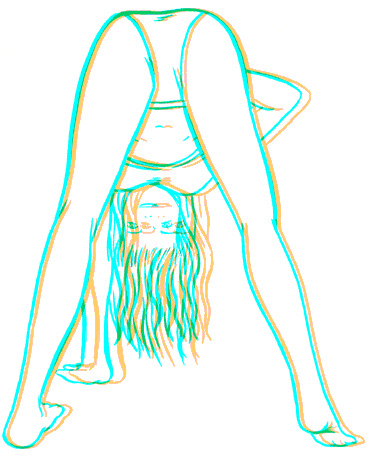
|
| Tell A Friend |
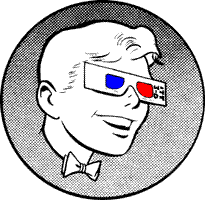
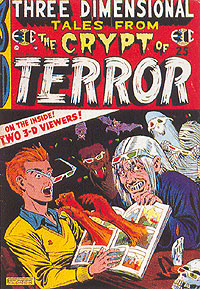 Most 3-D movies are made using a polarized process, which doesn't require the introduction of colored filters to create the 3-D effect. The black and white films of the 50s didn't use the red and blue glasses most people associate with 3-D, although they still required special lenses to get the correct effect. The anaglyphic method was traditionally used for 3-D television and print viewing.
Most 3-D movies are made using a polarized process, which doesn't require the introduction of colored filters to create the 3-D effect. The black and white films of the 50s didn't use the red and blue glasses most people associate with 3-D, although they still required special lenses to get the correct effect. The anaglyphic method was traditionally used for 3-D television and print viewing.
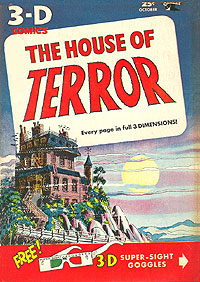 The anaglyph technique works well for line drawings and black and white photographs as long as the glasses and printed colors match well. Attempts have been made to use anaglyphic 3-D with color photos and color TV with mixed to poor results. 3-D films from the 1950s have been shown on television in most every major US market. MTV broadcast Robot Monster in 3-D complete with their own added comedy footage interspersed. The recent release of Spy Kids 3 was the only theatrical anaglyphic film that has been released in decades. Thankfully, careful attention was paid to both the theatrical and video releases, and the effect works fairly well.
The anaglyph technique works well for line drawings and black and white photographs as long as the glasses and printed colors match well. Attempts have been made to use anaglyphic 3-D with color photos and color TV with mixed to poor results. 3-D films from the 1950s have been shown on television in most every major US market. MTV broadcast Robot Monster in 3-D complete with their own added comedy footage interspersed. The recent release of Spy Kids 3 was the only theatrical anaglyphic film that has been released in decades. Thankfully, careful attention was paid to both the theatrical and video releases, and the effect works fairly well.
 My first exposure to 3-D comic books was a Mighty Mouse 3-D comic that I bought at a flea market in 7th grade. This was from 1953 and was actually the first 3-D comic book ever produced. The comic was a huge success, selling out its first print run and requiring a second. 3-D comics cost 25-cents at a time when most comic books were a dime, so naturally, publishers were eager to reproduce this success. Many companies produced 3-D comics during 1953 and 1954.
My first exposure to 3-D comic books was a Mighty Mouse 3-D comic that I bought at a flea market in 7th grade. This was from 1953 and was actually the first 3-D comic book ever produced. The comic was a huge success, selling out its first print run and requiring a second. 3-D comics cost 25-cents at a time when most comic books were a dime, so naturally, publishers were eager to reproduce this success. Many companies produced 3-D comics during 1953 and 1954. 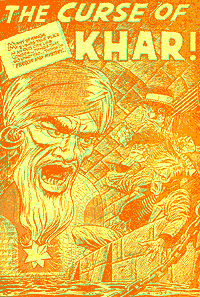 Legendary publisher EC Comics published two very well-produced 3-D comics and completed a third that was never printed. After their initial success, 3-D comics were found only rarely for several decades. In the 1970s, for example, Deep 3-D was published by Kitchen Sink Press and sold only through the underground “head shop” market. National Lampoon released a 3-D issue with comics and photos in anaglyphic 3-D. Possibly the best part of the issue is a painting of Stevie Wonder wearing a pair of 3-D glasses on the cover. Other 3-D titles would pop up occasionally but until the revival in the late 1980s, 3-D comics were rarely seen.
Legendary publisher EC Comics published two very well-produced 3-D comics and completed a third that was never printed. After their initial success, 3-D comics were found only rarely for several decades. In the 1970s, for example, Deep 3-D was published by Kitchen Sink Press and sold only through the underground “head shop” market. National Lampoon released a 3-D issue with comics and photos in anaglyphic 3-D. Possibly the best part of the issue is a painting of Stevie Wonder wearing a pair of 3-D glasses on the cover. Other 3-D titles would pop up occasionally but until the revival in the late 1980s, 3-D comics were rarely seen.
